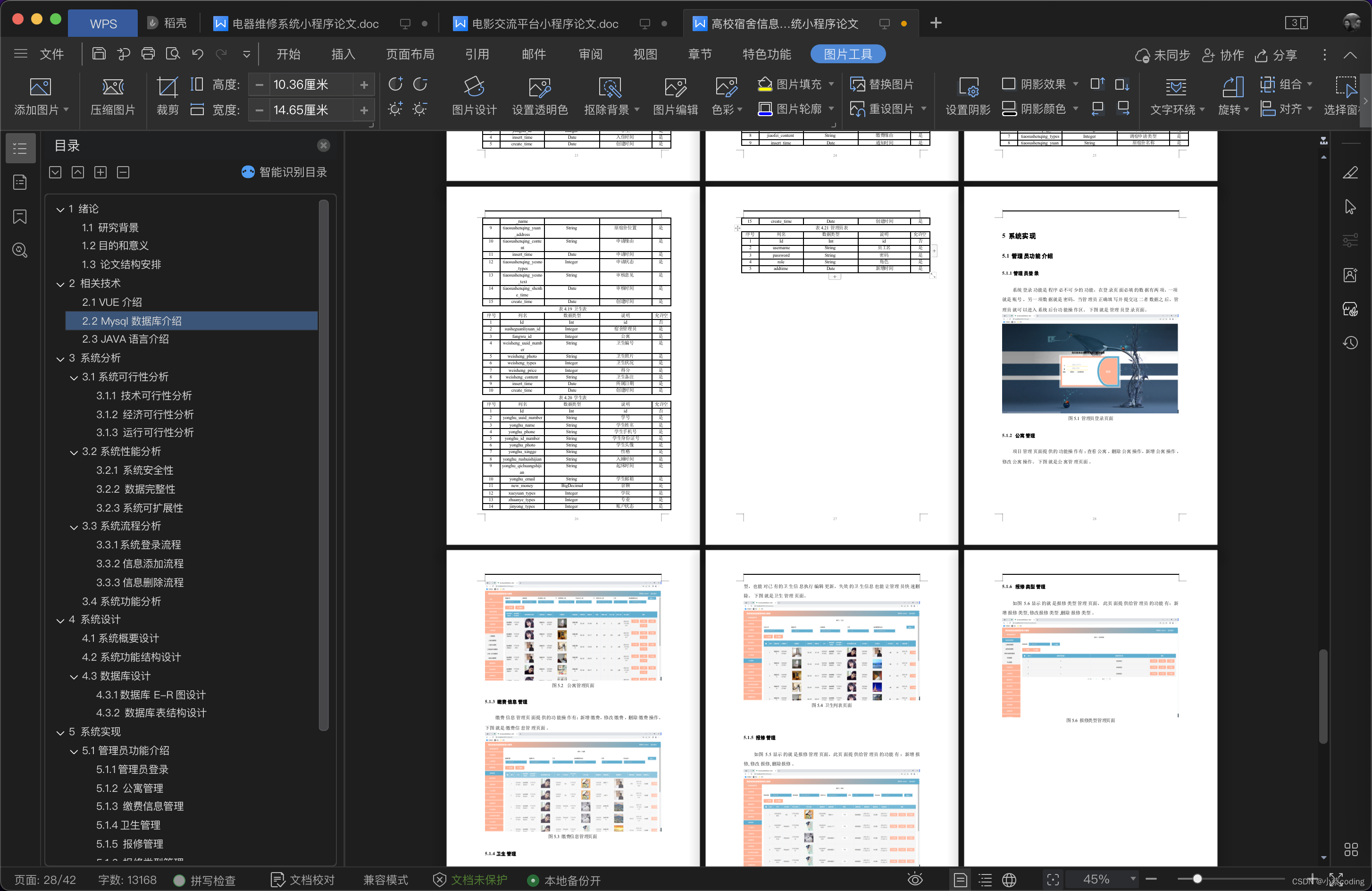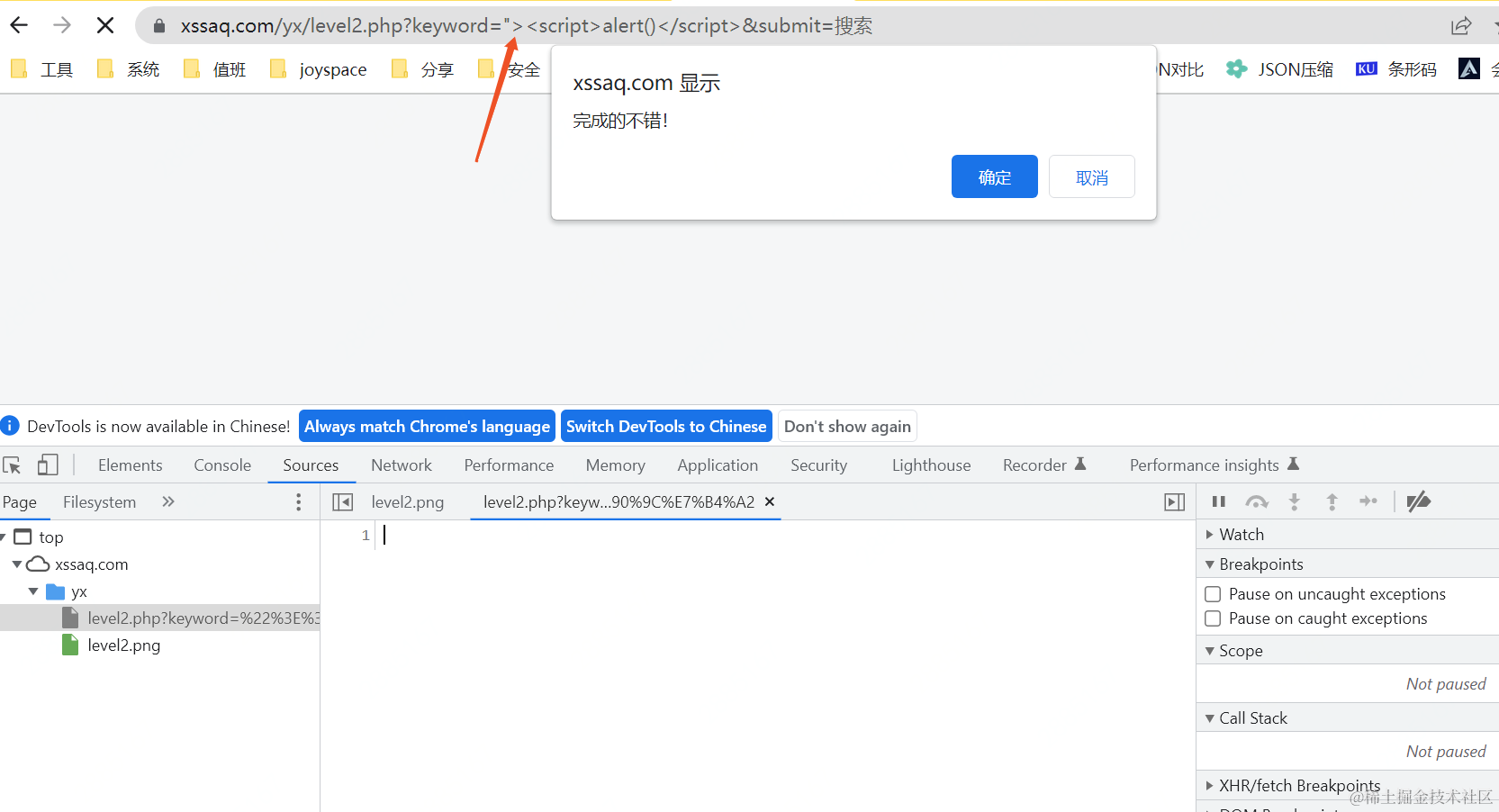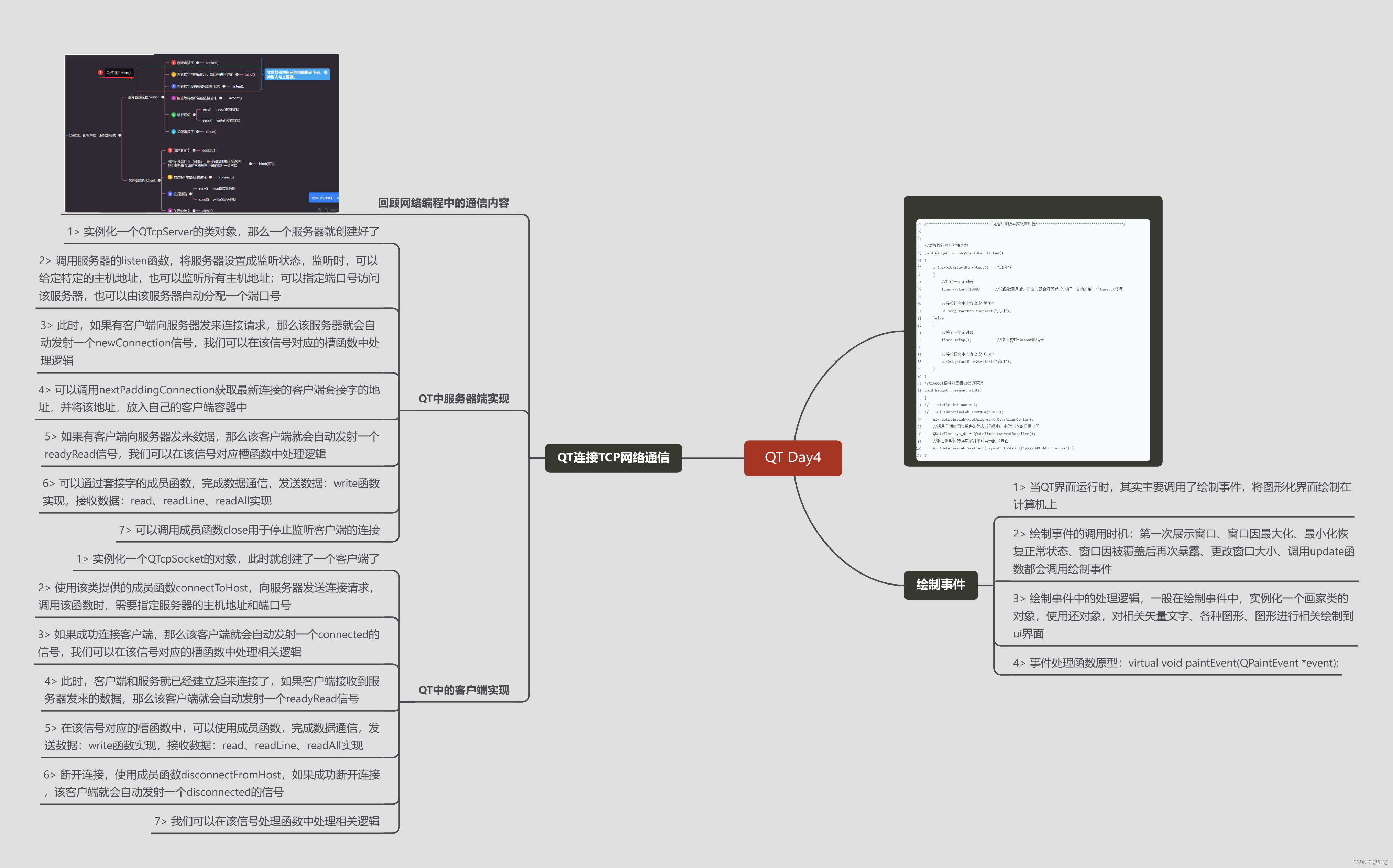文章目录
- 一、简介
- 1、定义
- 2、基础架构
- 二、快速入门
- 1、解压Flume
- 2、案例一:监控端口号
- 3、案例二:将空目录下文件
- 三、Flume进阶
- 1、Flume事务
- 2、Flume Agent内部原理
- 3、案例一:监控日志
- 4、案例二:多路复用和拦截器适应
- 4.1 原理
- 4.2 代码编写
- 4.3 编写配置文件
- 4.4 测试
- 5、案例三:聚合
- 四、Flume数据流监控
- 1、Ganglia简介
- 2、部署规划
- 3、修改配置文件:`hadoop101`
- 4、修改配置文件`3台`
- 5、启动服务
- 3、测试
一、简介
1、定义
Flume是Cloudera提供的一个高可用的,高可靠的,分布式的海量日志采集、聚合和传输的系统。
Flume基于流式架构,灵活简单。
- Flume官网地址:http://flume.apache.org/
- 文档查看地址:http://flume.apache.org/FlumeUserGuide.html
- 下载地址:http://archive.apache.org/dist/flume/

2、基础架构
Flume组成架构如下图所示:

- Agent
Agent:Flume的部署单元,本质是一个JVM进程,Agent内部是以事件的形式将数据从源头送至目的。
组成:Agent主要有3个部分组成,Source、Channel、Sink。
- Source
Source:是负责接收数据到Flume Agent的组件。
特点:Source组件可以处理各种类型、各种格式的日志数据,
Source组件类型:
avro:本质是RPC框架,支持跨语言、跨平台的数据传输,avro Source在flume中多用于Agent的连接。netcat:本质是Linux下的端口类工具,netcat Source在Flume中用于采集端口传输的数据。exec:支持执行命令的,并将命令执行后的标准输出作为数据采集,多用于采集一个可追加文件。spooling directory:支持对一个目录进行监听,采集目录中一个或多个新生成的文件数据。taildir:支持对多个目录进行监听,采集一个或多个目录下的一个或多个可追加文件,支持断点续传。- 除此之外还有:thrift、jms、sequence generator、syslog、http、自定义Source。
- Sink
Sink:是负责发送数据到外部系统的Flume Agent的组件。
特点:Sink组件不断地轮询Channel中的事件且批量地移除它们,并将这些事件批量的、事务的写入到存储或索引系统、或者被发送到另一个Flume Agent。
Sink组件类型:
logger:logger Sink组件则是将数据写到成Flume框架的运行日志中,配合运行参数-Dflume.root.logger=INFO,console可以将Flume运行日志(其中就包含了采集的数据)输出到控制台,多用于测试环境。hdfs:hdfs Sink组件是负责将数据传输到HDFS分布式文件系统中。avro:avro Sink组件配合avro Source组件可以实现Agent的连接。file:file Sink组件是将采集到的数据直接输出到本地文件系统中,即linux的磁盘上。- 除此之外还有:thrift、ipc、HBase、solr、自定义Sink。
- Channel
**Channel:**是负责暂存数据的,是位于Source和Sink组件之间的缓冲区。
特点:
- 由于Channel组件的存在,使得Source和Sink组件可以运作在不同的速率上。
- Channel是线程安全的,可以同时处理几个Source的写入操作和几个Sink的读取操作。
Flume自带两种Channel:
- Memory Channel:基于内存的队列存储事件,适用于对数据安全性要求不高的场景。 快,不安全
- File Channel:基于磁盘存储事件,宕机数据不丢失,适用于对数据安全敏感度高的场景。 慢,安全
- Event
Event: agent中的事件,Flume数据传输的基本单元,以Event的形式将数据从源头送至目的地。
特点: Event由Header和Body两部分组成,
- Header:用来存放该event的一些属性,为K-V结构。
- Body:用来存放该条数据,形式为字节数组。
二、快速入门
1、解压Flume
wget https://gitcode.net/weixin_44624117/software/-/raw/master/software/Linux/Flume/apache-flume-1.9.0-bin.tar.gz
解压文件
tar -zxvf apache-flume-1.9.0-bin.tar.gz -C /opt/module/
修改文件目录名称
mv /opt/module/apache-flume-1.9.0-bin /opt/module/flume-1.9.0
将lib文件夹下的guava-11.0.2.jar删除以兼容Hadoop 3.1.3
rm /opt/module/flume-1.9.0/lib/guava-11.0.2.jar
2、案例一:监控端口号
使用Flume监听一个端口,收集该端口数据,并打印到控制台。

安装netcat工具(发送Http请求)
sudo yum install -y nc
判断44444端口是否被占用
sudo netstat -nlp | grep 44444
在Flume目录下,创建job任务
cd /opt/module/flume-1.9.0
mkdir -p job/simpleCase
cd /opt/module/flume-1.9.0/job/simpleCase
添加配置文件
注:配置文件来源于官方手册http://flume.apache.org/FlumeUserGuide.html
vim flume-1-netcat-logger.con
#Name the components on this agent
a1.sources = r1
a1.sinks = k1
a1.channels = c1# Describe/configure the source
a1.sources.r1.type = netcat
a1.sources.r1.bind = localhost
a1.sources.r1.port = 44444# Describe the sink
a1.sinks.k1.type = logger # Use a channel which buffers events in memory
a1.channels.c1.type = memory
a1.channels.c1.capacity = 1000
a1.channels.c1.transactionCapacity = 100 # Bind the source and sink to the channel
a1.sources.r1.channels = c1
a1.sinks.k1.channel = c1
解释:
#Name the components on this agent
a1.sources = r1 # 为a1的Source组件命名为r1,多个组件用空格间隔
a1.sinks = k1 # 为a1的Sink组件命名为k1,多个组件用空格间隔
a1.channels = c1 # 为a1的Channel组件命名为c1,多个组件用空格间隔# Describe/configure the source
a1.sources.r1.type = netcat # 配置r1的类型
a1.sources.r1.bind = localhost # 配置r1的绑定地址(注意localhost和hadoop102的区别)
a1.sources.r1.port = 44444 # 配置r1的监听端口# Describe the sink
a1.sinks.k1.type = logger # 配置k1的类型为logger,输出到控制台# Use a channel which buffers events in memory
a1.channels.c1.type = memory # 配置c1的类型为memory
a1.channels.c1.capacity = 1000 # 配置c1的容量为1000个事件
a1.channels.c1.transactionCapacity = 100 # 配置c1的事务容量为100个事件# Bind the source and sink to the channel
a1.sources.r1.channels = c1 # 配置r1的channel属性,指定r1连接到那个channel
a1.sinks.k1.channel = c1 # 配置k1的channel属性,指定k1连接到那个channel
运行Flume监听端口
# 方式一:
bin/flume-ng agent --conf conf/ --name a1 --conf-file job/simpleCase/flume-1-netcat-logger.conf -Dflume.root.logger=INFO,console
# 方式二:bin/flume-ng agent -c conf/ -n a1 -f job/simpleCase/flume-1-netcat-logger.conf -Dflume.root.logger=INFO,console
参数说明:
--conf/-c:表示配置文件存储在conf/目录--name/-n:表示给agent起名为a1--conf-file/-f:指定读取的配置文件是在job/simpleCase文件夹下的flume-1-1netcat-logger.conf文件。-Dflume.root.logger=INFO,console:-D表示flume运行时动态修改flume.root.logger参数属性值,并将控制台日志打印级别设置为INFO级别。日志级别包括:log、info、warn、error。
**测试:**在Hadoop101上启动nc,并发送请求
nc localhost 44444
hello
world
hello world
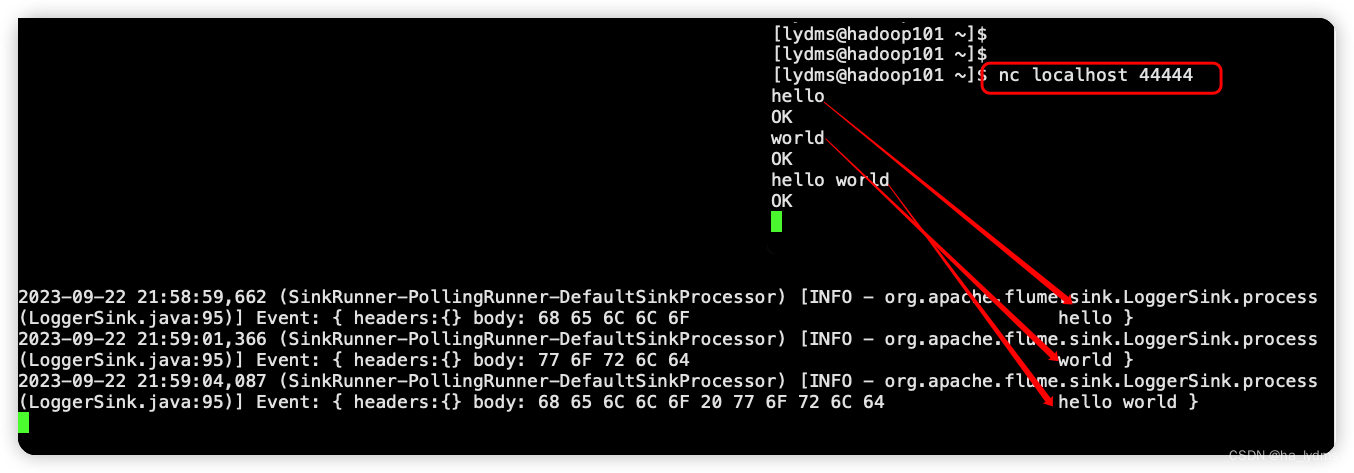
3、案例二:将空目录下文件
Source选择:
- Exec source:适用于监控一个实时追加的文件,不能实现断点续传;
- Spooldir Source:适合用于同步新文件,但不适合对实时追加日志的文件进行监听并同步;
- Taildir Source:适合用于监听多个实时追加的文件,并且能够实现断点续传。
案例需求:
- 使用Flume监听整个目录的实时追加文件,并上传至HDFS。
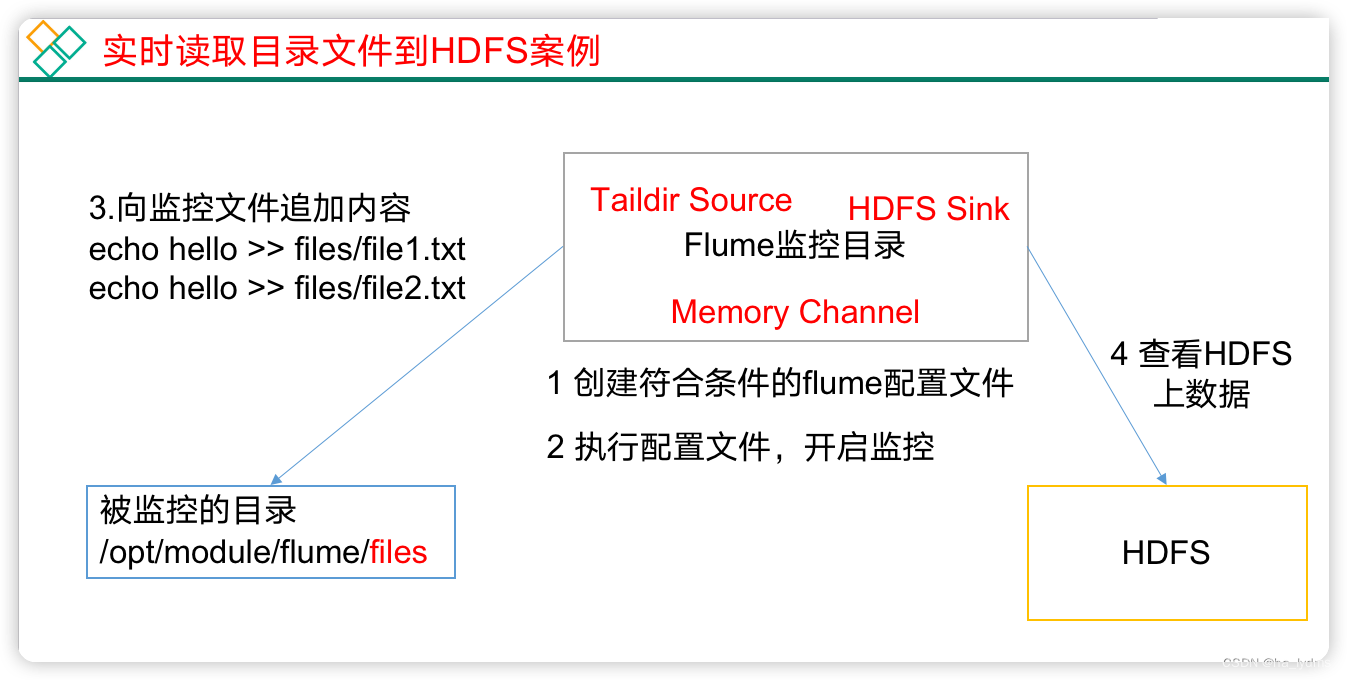
创建配置文件
cd /opt/module/flume-1.9.0/job/simpleCase
vim flume-2-taildir-hdfs.conf
配置文件
# Name the components on this agent
a2.sources = r1
a2.sinks = k1
a2.channels = c1# Describe/configure the source
a2.sources.r1.type = TAILDIR
a2.sources.r1.positionFile = /opt/module/flume-1.9.0/tail_dir.json
a2.sources.r1.filegroups = f1 f2
a2.sources.r1.filegroups.f1 = /opt/module/flume-1.9.0/datas/tailCase/files/.*file.*
a2.sources.r1.filegroups.f2 = /opt/module/flume-1.9.0/datas/tailCase/logs/.*log.*# Describe the sink
a2.sinks.k1.type = hdfs
a2.sinks.k1.hdfs.path = hdfs://hadoop101:8020/flume/tailDir/%Y%m%d/%H
# 上传文件的前缀
a2.sinks.k1.hdfs.filePrefix = tail-
# 是否按照时间滚动文件夹
a2.sinks.k1.hdfs.round = true
# 多少时间单位创建一个新的文件夹
a2.sinks.k1.hdfs.roundValue = 1
# 重新定义时间单位
a2.sinks.k1.hdfs.roundUnit = hour
# 是否使用本地时间戳
a2.sinks.k1.hdfs.useLocalTimeStamp = true
# 积攒多少个Event才flush到HDFS一次
a2.sinks.k1.hdfs.batchSize = 100
# 设置文件类型,(可选择设置支持压缩的CompressedStream或者不支持压缩的DataStream)
a2.sinks.k1.hdfs.fileType = DataStream
# 多久生成一个新的文件
a2.sinks.k1.hdfs.rollInterval = 60
# 设置每个文件的滚动大小大概是128M
a2.sinks.k1.hdfs.rollSize = 134217700
# 文件的滚动与Event数量无关
a2.sinks.k1.hdfs.rollCount = 0# Use a channel which buffers events in memory
a2.channels.c1.type = memory
a2.channels.c1.capacity = 1000
a2.channels.c1.transactionCapacity = 100# Bind the source and sink to the channel
a2.sources.r1.channels = c1
a2.sinks.k1.channel = c1
启动监控
cd /opt/module/flume-1.9.0
bin/flume-ng agent --conf conf/ --name a2 --conf-file job/simpleCase/flume-2-taildir-hdfs.conf
测试
新建受监控目录
mkdir -p datas/tailCase/files
mkdir -p datas/tailCase/logs
在/opt/module/flume/datas/目录下创建tailCase/files文件夹向files文件夹下文件追加内容
测试/opt/module/flume-1.9.0/datas/tailCase/files/.*file.*
# 当前目录下会上传file的文件
cd /opt/module/flume-1.9.0/datas/tailCase/filestouch file1.txt
echo I am file1 >> file1.txt
touch log1.txt
echo I am log1 >> log1.txt
测试: /opt/module/flume-1.9.0/datas/tailCase/logs/.*log.*
# 当前目录下,会上传 log的文件
cd /opt/module/flume-1.9.0/datas/tailCase/logs
touch file2.txt
echo I am file2 >> file2.txt
touch log2.txt
echo I am log2 >> log2.txt
文件上传到HDFS上

断点续传监控
关掉flume采集程序,对logs/和files/下文件追加,再开启flume采集程序,验证flume的断点续传。
Taildir Source维护了一个json格式的position File,其会定期的往position File中更新每个文件读取到的最新的位置,因此能够实现断点续传。Position File的格式如下:
{"inode":2496272,"pos":12,"file":"/opt/module/flume/datas/tailCase/files/file1.txt"}
{"inode":2496275,"pos":12,"file":"/opt/module/flume/datas/tailCase/logs/log2.txt"}
注:Linux中储存文件元数据的区域就叫做inode,每个inode都有一个号码,操作系统用inode号码来识别不同的文件,Unix/Linux系统内部不使用文件名,而使用inode号码来识别文件。
三、Flume进阶
1、Flume事务
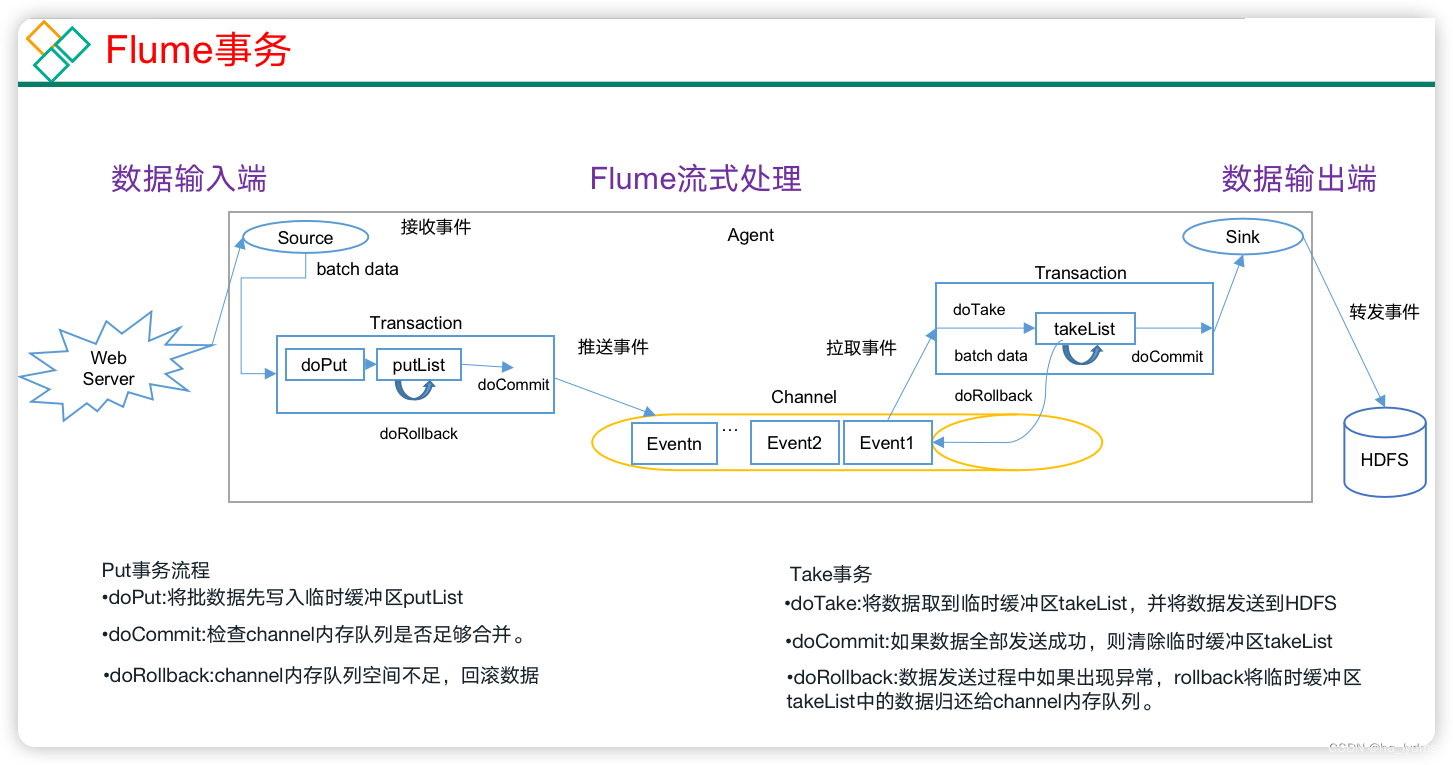
在Flume中一共有两个事务
- Put事务:在Source组件和Channel组件之间,保证Source组件到Channel组件之间数据传递的可靠性。
- take事务:在Channel组件和Sink组件之间,保证channel组件到Sink组件之间数据传输的可靠性。
Put事务流程
- source组件采集外部数据到agent内部,并且将数据包装为事件。
- source组件开始将事件传输到Channel组件中。
- 首先,会开启事务,在事务内部,通过doPut方法将一批数据放入到putlist中存储。
- 之后,调用doCommit方法,把putList中的所有Event放到Channel中,成功之后就清空putList。
失败重试机制
- putList在像channel中发送数据前会先检查channel中的容量是否放得下,放不下一个都不会放,调用doRollback
- 调用doRollback方法后,doRollback方法会进行两步操作:
- 将putList清空。
- 抛出ChannelException异常。
- source组件会捕捉到doRollback抛出的异常后,source就将刚才的一批数据重新采集,然后就开启一个新的事务。
- 数据批的大小取决于Source组件的配置参数batch size的值。
- putList的大小取决于Channel组件的配置参数transactionCapacity的值(capacity参数是指Channel的容量)。
Take事务流程
- Sink组件不断的轮询Channel,当其中有新的事件到达时,开启take事务。
- take事务开启后,会调用doTake方法将Channel组件中的Event剪切到takeList中。
- 当takeList中存放了batch size数量的Event之后,就会调用doCommit方法。
- doCommit方法中,首先会将数据写出到外部系统,成功后就会清空takeList。
- 当事务失败时,就会调用doRollback方法来进行回滚,就是将takeList中的数据原封不动的还给channel。
2、Flume Agent内部原理

| 组件名称 | 概述 | 组件包含类型 | 特点 |
|---|---|---|---|
| ChannelSelector | 选出Event将要发到那个channel | Replication Channel Selector | 复制,默认选项 |
| Multiplexing Channel Seletctor | 多路复用 | ||
| SinkProcessor | 通过配置不同类型的SinkProcess实现不同的功能 | DefaultSinkProcessor | 单个Sink,默认 |
| LoadBalancingSinkProcessor | 负载均衡 | ||
| FailoverSinkProcessor | 故障转移 |
执行流程
- Source组件采集外部数据到agent内部,并包装为Event
- 然后,将事件发送到ChannelProcessor中,
- 通过拦截器链中每个拦截器的拦截过滤,符合要求的Event会返回到ChannelProcessor中。
- 在通过ChannelSelector,根据不同的选择器来决定Event去往哪个Channel,然后返回到ChannelProcessor。
- 开启Put事务,将批量的Event发送到Channel中
- 更具SinkProcessor组件配置的类型不同,实现相应的功能(负载均衡或故障转移),最终都会且同一时刻只能有一个Sink去拉取数据。
- Sink组件不断的轮询Channel,当有新的Event到达Channel时,向外部系统写出。
3、案例一:监控日志
需求:
- 使用Flume-1监控文件变动。
- Flume-1将变动内容传递给Flume-2,Flume-2负责存储到HDFS。
- 同时Flume-1将变动内容传递给Flume-3,Flume-3负责输出到Local FileSystem。
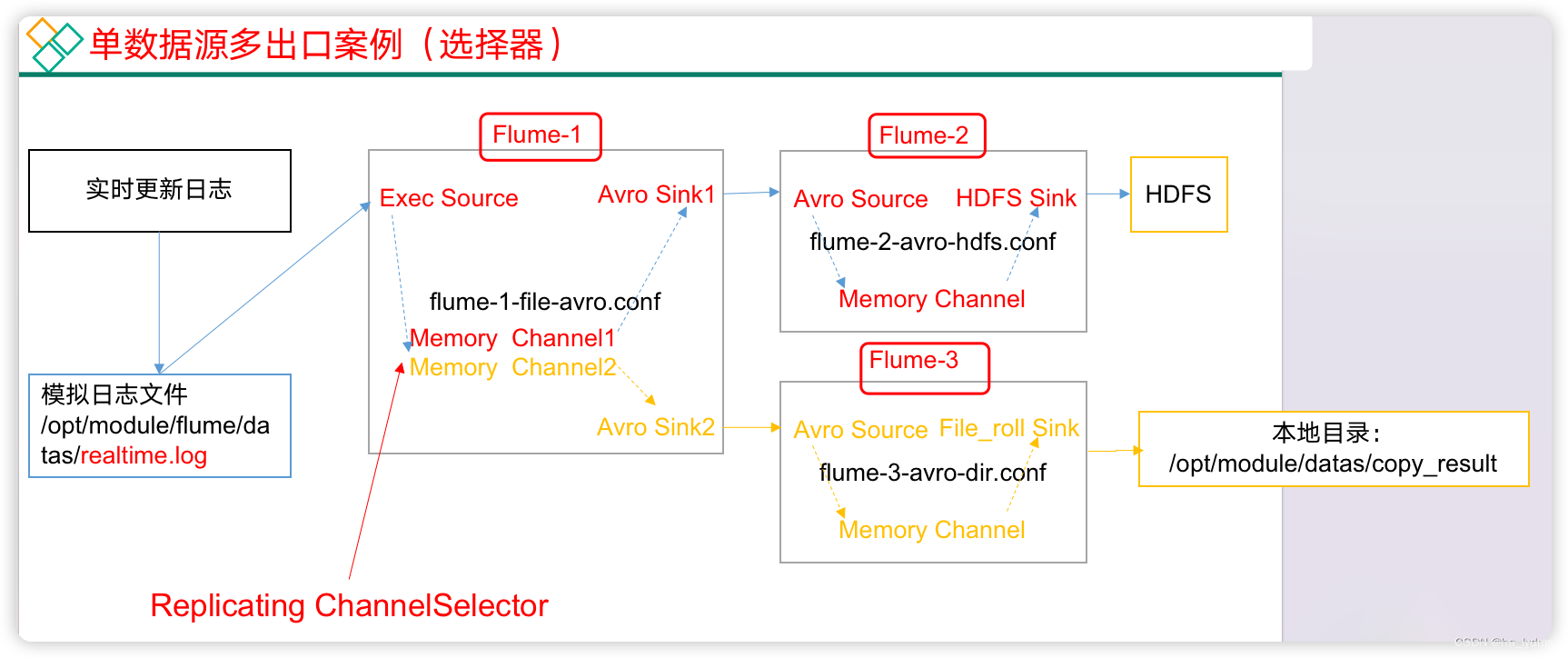
模拟日志文件:在/opt/module/flume/datas/目录下创建模拟日志文件realtime.log
mkdir -p /opt/module/flume-1.9.0/datas
touch /opt/module/flume-1.9.0/datas/realtime.log
复制的配置文件:在/opt/module/flume/job目录下创建enterprise/copy文件夹
mkdir -p /opt/module/flume-1.9.0/job/enterprise/copy
- Source:
flume-1-exec-avro.conf - Sink:``flume-2-avro-hdfs
和flume-3-avro-file`
配置文件1::flume-1-exec-avro.conf
vim /opt/module/flume-1.9.0/job/enterprise/copy/flume-1-exec-avro.conf
# Name the components on this agent
a1.sources = r1
a1.sinks = k1 k2
a1.channels = c1 c2
# 将数据流复制给所有channel,其实默认就是replicating
a1.sources.r1.selector.type = replicating# Describe/configure the source
a1.sources.r1.type = exec
a1.sources.r1.command = tail -F /opt/module/flume-1.9.0/datas/realtime.log
a1.sources.r1.shell = /bin/bash -c# Describe the sink
# sink端的avro是一个数据发送者
a1.sinks.k1.type = avro
a1.sinks.k1.hostname = hadoop101
a1.sinks.k1.port = 4141a1.sinks.k2.type = avro
a1.sinks.k2.hostname = hadoop101
a1.sinks.k2.port = 4142# Describe the channel
a1.channels.c1.type = memory
a1.channels.c1.capacity = 1000
a1.channels.c1.transactionCapacity = 100a1.channels.c2.type = memory
a1.channels.c2.capacity = 1000
a1.channels.c2.transactionCapacity = 100# Bind the source and sink to the channel
a1.sources.r1.channels = c1 c2
a1.sinks.k1.channel = c1
a1.sinks.k2.channel = c2
配置文件2:flume-2-avro-hdfs.conf
vim /opt/module/flume-1.9.0/job/enterprise/copy/flume-2-avro-hdfs.conf
# Name the components on this agent
a2.sources = r1
a2.sinks = k1
a2.channels = c1# Describe/configure the source
# source端的avro是一个数据接收服务
a2.sources.r1.type = avro
a2.sources.r1.bind = hadoop101
a2.sources.r1.port = 4141# Describe the sink
a2.sinks.k1.type = hdfs
a2.sinks.k1.hdfs.path = hdfs://hadoop101:8020/flume/copy/%Y%m%d/%H
# 上传文件的前缀
a2.sinks.k1.hdfs.filePrefix = copy-
# 是否按照时间滚动文件夹
a2.sinks.k1.hdfs.round = true
# 多少时间单位创建一个新的文件夹
a2.sinks.k1.hdfs.roundValue = 1
# 重新定义时间单位
a2.sinks.k1.hdfs.roundUnit = hour
# 是否使用本地时间戳
a2.sinks.k1.hdfs.useLocalTimeStamp = true
# 积攒多少个Event才flush到HDFS一次
a2.sinks.k1.hdfs.batchSize = 100
# 设置文件类型,可支持压缩
a2.sinks.k1.hdfs.fileType = DataStream
# 多久生成一个新的文件
a2.sinks.k1.hdfs.rollInterval = 60
# 设置每个文件的滚动大小大概是128M
a2.sinks.k1.hdfs.rollSize = 134217700
# 文件的滚动与Event数量无关
a2.sinks.k1.hdfs.rollCount = 0# Describe the channel
a2.channels.c1.type = memory
a2.channels.c1.capacity = 1000
a2.channels.c1.transactionCapacity = 100# Bind the source and sink to the channel
a2.sources.r1.channels = c1
a2.sinks.k1.channel = c1
配置文件3:flume-3-avro-file.conf
vim /opt/module/flume-1.9.0/job/enterprise/copy/flume-3-avro-file.conf
# Name the components on this agent
a3.sources = r1
a3.sinks = k1
a3.channels = c2# Describe/configure the source
a3.sources.r1.type = avro
a3.sources.r1.bind = hadoop101
a3.sources.r1.port = 4142# Describe the sink
a3.sinks.k1.type = file_roll
a3.sinks.k1.sink.directory = /opt/module/flume-1.9.0/datas/copy_result# Describe the channel
a3.channels.c2.type = memory
a3.channels.c2.capacity = 1000
a3.channels.c2.transactionCapacity = 100# Bind the source and sink to the channel
a3.sources.r1.channels = c2
a3.sinks.k1.channel = c2
mkdir /opt/module/flume-1.9.0/datas/copy_result
cd /opt/module/flume-1.9.0
bin/flume-ng agent -c conf/ -n a3 -f /opt/module/flume-1.9.0/job/enterprise/copy/flume-3-avro-file.conf
bin/flume-ng agent -c conf/ -n a2 -f /opt/module/flume-1.9.0/job/enterprise/copy/flume-2-avro-hdfs.conf
bin/flume-ng agent -c conf/ -n a1 -f /opt/module/flume-1.9.0/job/enterprise/copy/flume-1-exec-avro.conf
echo 2021-10-41 09-10-32 >> /opt/module/flume-1.9.0/datas/realtime.log
4、案例二:多路复用和拦截器适应
4.1 原理
需求:
使用flume采集服务器端口日志数据,需要按照日志类型的不同,将不同种类的日志发往不同分析系统。
原理
- 背景:在实际的开发中,一台服务器产生的日志类型可能有很多种,不同类型的日志可能需要发送到不同的分析系统。
此时会用到Flume的channel selecter中的Multiplexing结构。 - Multiplexing的原理是:根据event中Header的某个key的值,将不同的event发送到不同的Channel中。
- 自定义Interceptor:实现为不同类型的event的Header中的key赋予不同的值。
- 总结:在该案例中,我们以端口数据模拟日志,以数字和字母模拟不同类型的日志,我们需要自定义interceptor区分数字和字母,将其分别发往不同的分析系统(Channel)。
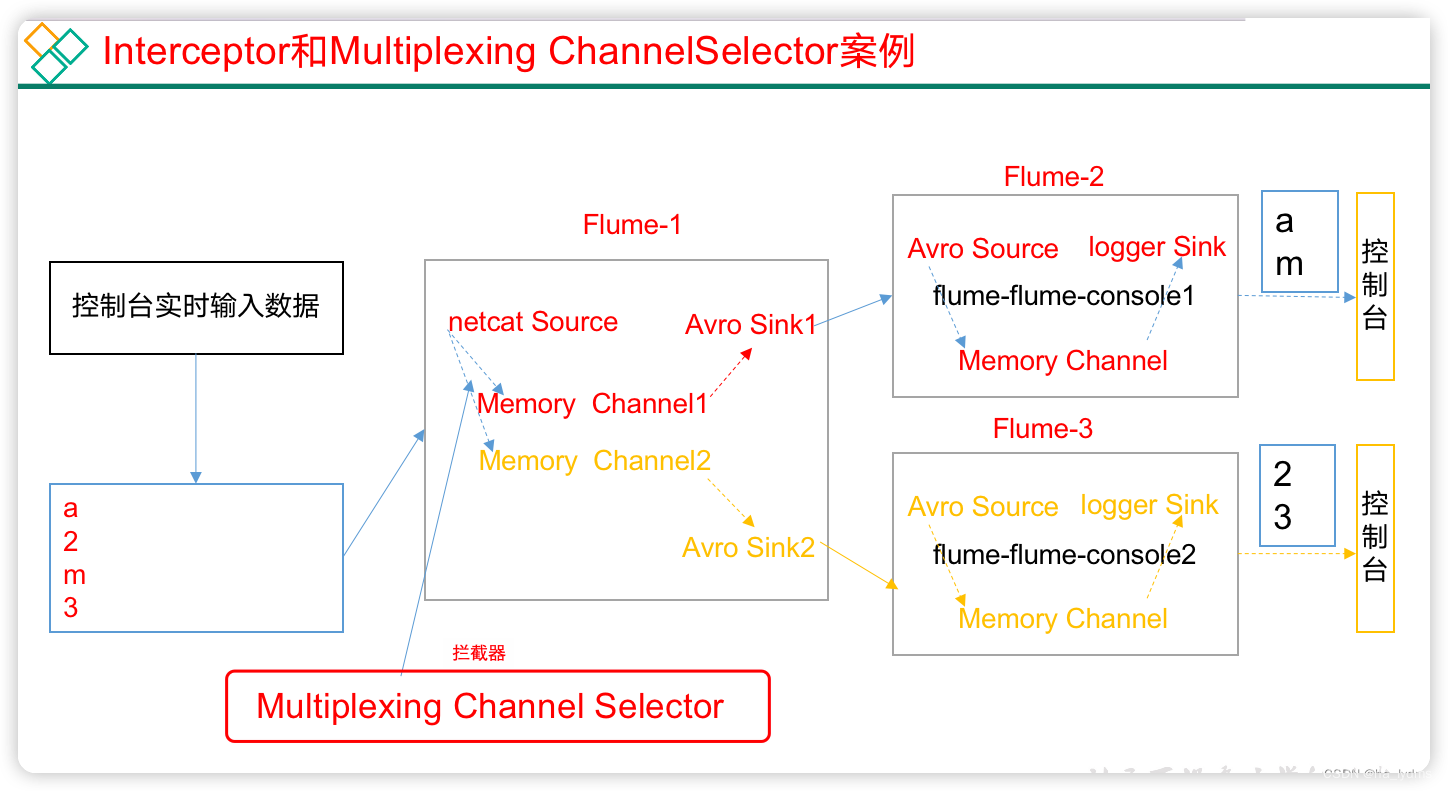
4.2 代码编写
Maven配置
<project xmlns="http://maven.apache.org/POM/4.0.0" xmlns:xsi="http://www.w3.org/2001/XMLSchema-instance"xsi:schemaLocation="http://maven.apache.org/POM/4.0.0 http://maven.apache.org/xsd/maven-4.0.0.xsd"><modelVersion>4.0.0</modelVersion><groupId>com.lydms</groupId><artifactId>first-flume</artifactId><version>1.0-SNAPSHOT</version><packaging>jar</packaging><name>first-flume</name><properties><project.build.sourceEncoding>UTF-8</project.build.sourceEncoding></properties><dependencies><dependency><groupId>junit</groupId><artifactId>junit</artifactId><version>3.8.1</version><scope>test</scope></dependency><dependency><groupId>org.apache.flume</groupId><artifactId>flume-ng-core</artifactId><version>1.9.0</version></dependency></dependencies><build><plugins><plugin><groupId>org.apache.maven.plugins</groupId><artifactId>maven-compiler-plugin</artifactId><configuration><source>6</source><target>6</target></configuration></plugin></plugins></build>
</project>
接口:
package com.lydms.flume.interceptor;import org.apache.flume.Context;
import org.apache.flume.Event;
import org.apache.flume.interceptor.Interceptor;import java.util.List;public class CustomInterceptor implements Interceptor {@Overridepublic void initialize() {}@Overridepublic Event intercept(Event event) {// 1. 从事件中获取数据byte[] body = event.getBody();// 2. 判断数据开头的字符是字母还是数据if (body[0] >= 'a' && body[0] <= 'z') {event.getHeaders().put("type", "letter"); // 是字母就在事件头部设置type类型为letter} else if (body[0] >= '0' && body[0] <= '9') {event.getHeaders().put("type", "number"); // 是数字就在事件头部设置type类型为number}// 3. 返回事件return event;}// 对批量事件进行拦截@Overridepublic List<Event> intercept(List<Event> events) {for (Event event : events) {intercept(event);}return events;}@Overridepublic void close() {}// 拦截器对象的构造对象public static class Builder implements Interceptor.Builder {@Overridepublic Interceptor build() {return new CustomInterceptor();}@Overridepublic void configure(Context context) {}}
}将项目打包,并导入到flume的lib目录下(/opt/module/flume-1.9.0/lib)。
4.3 编写配置文件
Hadoop101:添加配置文件
mkdir -p /opt/module/flume-1.9.0/job/custom/multi
vim /opt/module/flume-1.9.0/job/custom/multi/flume-1-netcat-avro.conf
# Name the components on this agent
a1.sources = r1
a1.sinks = k1 k2
a1.channels = c1 c2# Describe/configure the source
a1.sources.r1.type = netcat
a1.sources.r1.bind = localhost
a1.sources.r1.port = 44444
a1.sources.r1.interceptors = i1
# Java文件目录
a1.sources.r1.interceptors.i1.type = com.lydms.flume.interceptor.CustomInterceptor$Builder
a1.sources.r1.selector.type = multiplexing
a1.sources.r1.selector.header = type
a1.sources.r1.selector.mapping.letter = c1
a1.sources.r1.selector.mapping.number = c2# Describe the sink
a1.sinks.k1.type = avro
a1.sinks.k1.hostname = hadoop102
a1.sinks.k1.port = 4141a1.sinks.k2.type=avro
a1.sinks.k2.hostname = hadoop103
a1.sinks.k2.port = 4242# Use a channel which buffers events in memory
a1.channels.c1.type = memory
a1.channels.c1.capacity = 1000
a1.channels.c1.transactionCapacity = 100# Use a channel which buffers events in memory
a1.channels.c2.type = memory
a1.channels.c2.capacity = 1000
a1.channels.c2.transactionCapacity = 100# Bind the source and sink to the channel
a1.sources.r1.channels = c1 c2
a1.sinks.k1.channel = c1
a1.sinks.k2.channel = c2
Hadoop102:添加配置文件
mkdir -p /opt/module/flume-1.9.0/job/custom/multi
vim /opt/module/flume-1.9.0/job/custom/multi/flume-2-avro-logger.conf
# agent
a2.sources=r1
a2.sinks = k1
a2.channels = c1# source
a2.sources.r1.type = avro
a2.sources.r1.bind = hadoop102
a2.sources.r1.port = 4141# sink
a2.sinks.k1.type = logger# Channel
a2.channels.c1.type = memory
a2.channels.c1.capacity = 1000
a2.channels.c1.transactionCapacity = 100# bind
a2.sinks.k1.channel = c1
a2.sources.r1.channels = c1
Hadoop103:添加配置文件
mkdir -p /opt/module/flume-1.9.0/job/custom/multi
vim /opt/module/flume-1.9.0/job/custom/multi/flume-3-avro-logger.conf
# agent
a3.sources = r1
a3.sinks = k1
a3.channels = c1# source
a3.sources.r1.type = avro
a3.sources.r1.bind = hadoop103
a3.sources.r1.port = 4242# sink
a3.sinks.k1.type = logger# Channel
a3.channels.c1.type = memory
a3.channels.c1.capacity = 1000
a3.channels.c1.transactionCapacity = 100# bind
a3.sinks.k1.channel = c1
a3.sources.r1.channels = c1
4.4 测试
启动项目
cd /opt/module/flume-1.9.0
bin/flume-ng agent -c conf/ -n a3 -f /opt/module/flume-1.9.0/job/custom/multi/flume-3-avro-logger.conf -Dflume.root.logger=INFO,console
bin/flume-ng agent -c conf/ -n a2 -f /opt/module/flume-1.9.0/job/custom/multi/flume-2-avro-logger.conf -Dflume.root.logger=INFO,console
bin/flume-ng agent -c conf/ -n a1 -f /opt/module/flume-1.9.0/job/custom/multi/flume-1-netcat-avro.conf -Dflume.root.logger=INFO,console
测试:
nc localhost 44444
hello
world
1231231
41341
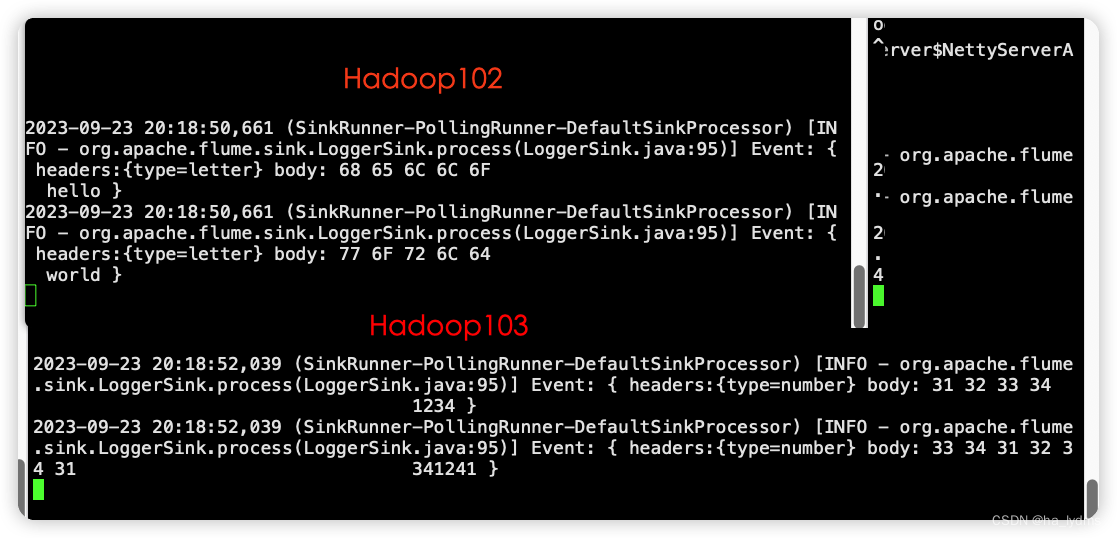
5、案例三:聚合
案例:
hadoop102:flume-1监控文件/opt/module/flume-1.9.0/datas/.*file*.,hadoop103:flume-2监控某一个端口的数据流。hadoop104:flume-3,接收flume-1和flume-2的数据,flume-3将最终数据打印到控制台。
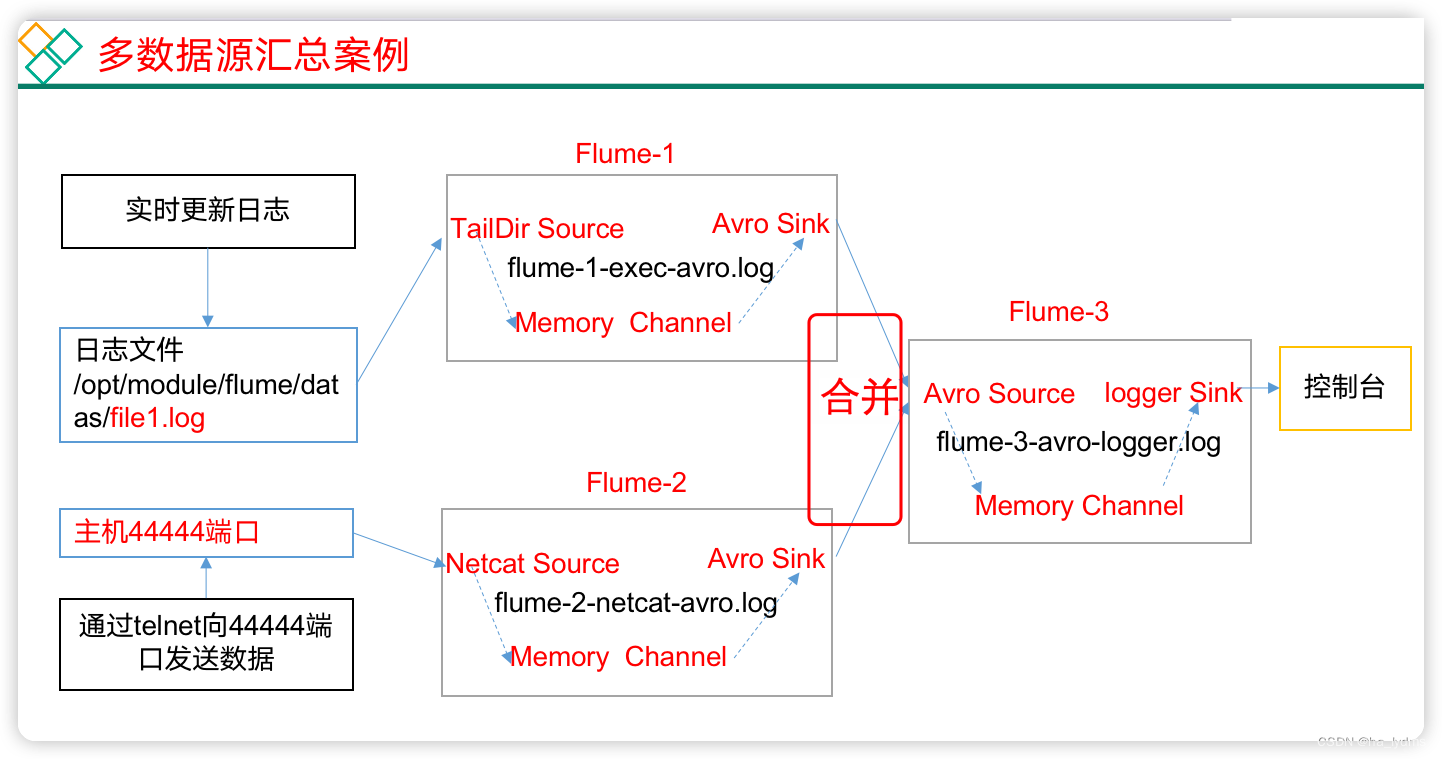
Hadoop101:配置文件flume-1-exec-avro.conf
mkdir /opt/module/flume-1.9.0/job/enterprise/juhe
vim /opt/module/flume-1.9.0/job/enterprise/juhe/flume-1-exec-avro.conf
# Name the components on this agent
a1.sources = r1
a1.sinks = k1
a1.channels = c1# Describe/configure the source
a1.sources.r1.type = exec
a1.sources.r1.command = tail -F /opt/module/flume-1.9.0/datas/realtime.log
a1.sources.r1.shell = /bin/bash -c# Describe the sink
a1.sinks.k1.type = avro
a1.sinks.k1.hostname = hadoop103
a1.sinks.k1.port = 4141# Describe the channel
a1.channels.c1.type = memory
a1.channels.c1.capacity = 1000
a1.channels.c1.transactionCapacity = 100# Bind the source and sink to the channel
a1.sources.r1.channels = c1
a1.sinks.k1.channel = c1
Hadoop102 :配置文件flume-2-netcat-avro.conf
mkdir -p /opt/module/flume-1.9.0/job/enterprise/juhe
vim /opt/module/flume-1.9.0/job/enterprise/juhe/flume-2-netcat-avro.conf
# Name the components on this agent
a2.sources = r1
a2.sinks = k1
a2.channels = c1# Describe/configure the source
a2.sources.r1.type = netcat
a2.sources.r1.bind = hadoop102
a2.sources.r1.port = 44444# Describe the sink
a2.sinks.k1.type = avro
a2.sinks.k1.hostname = hadoop103
a2.sinks.k1.port = 4141# Use a channel which buffers events in memory
a2.channels.c1.type = memory
a2.channels.c1.capacity = 1000
a2.channels.c1.transactionCapacity = 100# Bind the source and sink to the channel
a2.sources.r1.channels = c1
a2.sinks.k1.channel = c1
Hadoop103:配置文件flume-1-exec-avro.conf
mkdir -p /opt/module/flume-1.9.0/job/enterprise/juhe
vim /opt/module/flume-1.9.0/job/enterprise/juhe/flume-3-avro-logger.conf
# Name the components on this agent
a3.sources = r1
a3.sinks = k1
a3.channels = c1# Describe/configure the source
a3.sources.r1.type = avro
a3.sources.r1.bind = hadoop103
a3.sources.r1.port = 4141# Describe the sink
a3.sinks.k1.type = logger# Describe the channel
a3.channels.c1.type = memory
a3.channels.c1.capacity = 1000
a3.channels.c1.transactionCapacity = 100# Bind the source and sink to the channel
a3.sources.r1.channels = c1
a3.sinks.k1.channel = c1
测试:
# Hadoop103
/opt/module/flume-1.9.0/bin/flume-ng agent –c conf/ -n a3 -f /opt/module/flume-1.9.0/job/enterprise/juhe/flume-3-avro-logger.conf -Dflume.root.logger=INFO,console
# Hadoop102
/opt/module/flume-1.9.0/bin/flume-ng agent –c conf/ -n a2 -f /opt/module/flume-1.9.0/job/enterprise/juhe/flume-2-netcat-avro.conf
# Hadoop101
/opt/module/flume-1.9.0/bin/flume-ng agent –c conf/ -n a1 -f /opt/module/flume-1.9.0/job/enterprise/juhe/flume-1-exec-avro.conf
Hadoop101:向/opt/module/flume/datas/目录下的realtime.log追加内容
echo 'Hello Worlld Hadoop101' > /opt/module/flume-1.9.0/datas/realtime.log
Hadoop102:向44444端口发送数据
nc hadoop102 44444
hello world
Hadoop103:查看数据

四、Flume数据流监控
1、Ganglia简介
Ganglia由gmond、gmetad和gweb三部分组成。
- gmond(Ganglia Monitoring Daemon):
是一种轻量级服务,安装在每台需要收集指标数据的节点主机上。
使用gmond,你可以很容易收集很多系统指标数据,如CPU、内存、磁盘、网络和活跃进程的数据等。 - gmetad(Ganglia Meta Daemon):
整合所有信息,并将其以RRD格式存储至磁盘的服务。 - gweb(Ganglia Web)Ganglia可视化工具:
gweb是一种利用浏览器显示gmetad所存储数据的PHP前端。
在Web界面中以图表方式展现集群的运行状态下收集的多种不同指标数据。
2、部署规划
| gweb | gmetad | gmod | |
|---|---|---|---|
| Hadoop101 | ture | true | true |
| Hadoop102 | true | ||
| Hadoop103 | true |
安装步骤
# Hadoop101
sudo yum -y install epel-release
sudo yum -y install ganglia-gmetad
sudo yum -y install ganglia-web
sudo yum -y install ganglia-gmond# Hadoop102
sudo yum -y install epel-release
sudo yum -y install ganglia-gmond# Hadoop103
sudo yum -y install epel-release
sudo yum -y install ganglia-gmond
3、修改配置文件:hadoop101
修改配置:Hadoop101
- 修改配置文件
/etc/httpd/conf.d/ganglia.conf
sudo vim /etc/httpd/conf.d/ganglia.conf
# 修改内容(2种配置。二选一)
Require ip 192.168.1.1
# Require all granted
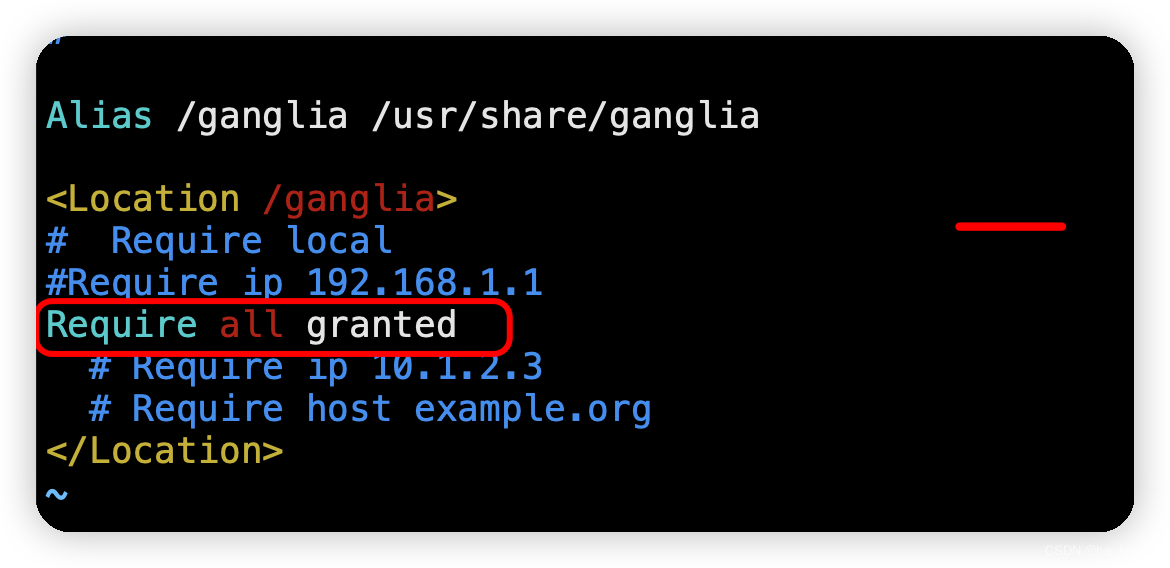
修改配置文件/etc/ganglia/gmetad.conf
sudo vim /etc/ganglia/gmetad.conf
# 修改内容
data_source "my cluster" hadoop101

修改配置文件/etc/selinux/config
sudo vim /etc/selinux/config
# 修改内容
SELINUX=disabled
SELINUXTYPE=targeted
4、修改配置文件3台
修改配置:Hadoop101、Hadoop102、Hadoop103
修改配置文件/etc/sudganglia/gmond.conf
sudo vim /etc/ganglia/gmond.conf
# 修改内容==================
# 数据发送给hadoop101
host = hadoop101# 接收来自任意连接的数据
bind = 0.0.0.0
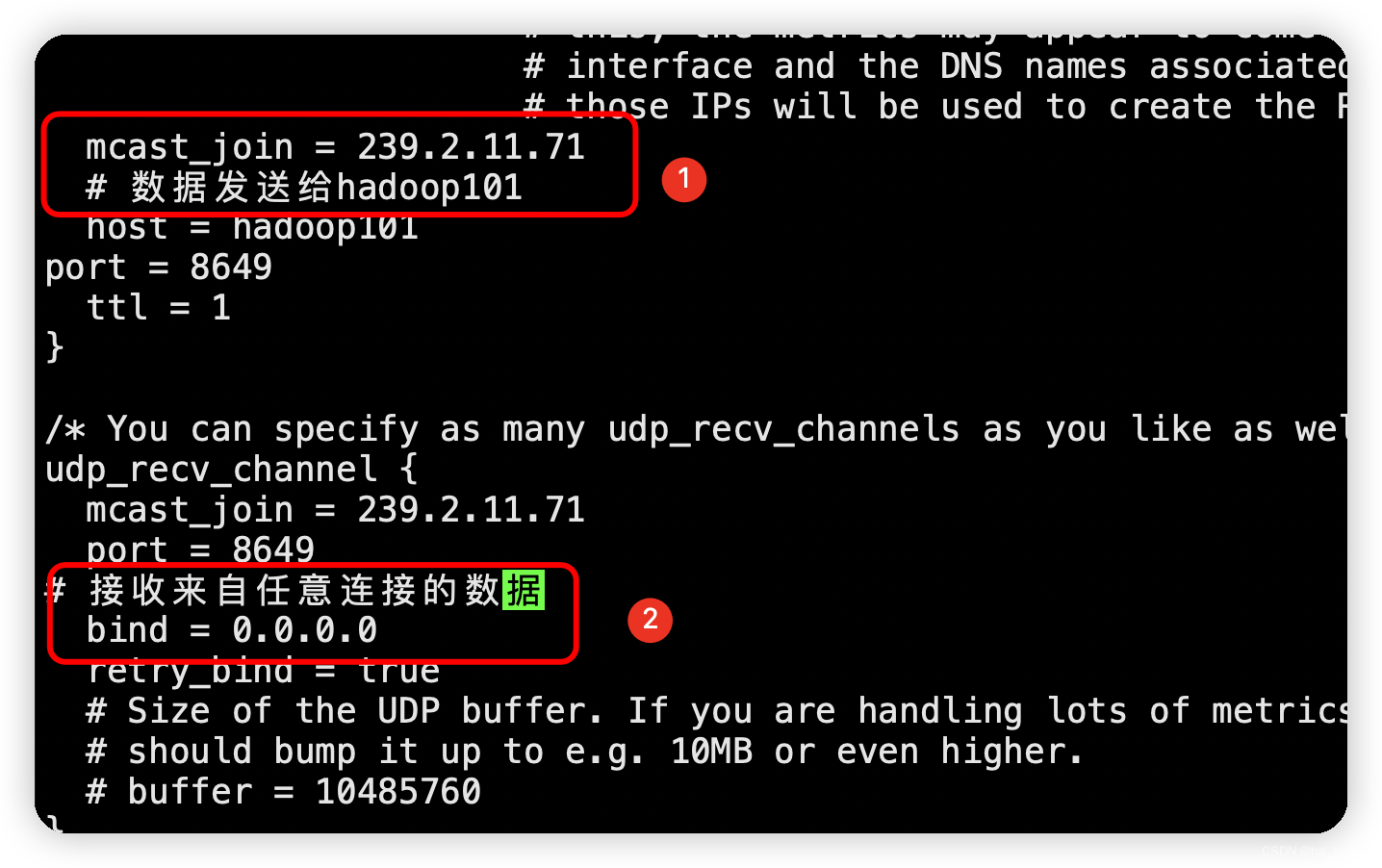
5、启动服务
修改文件权限
chown ganglia:ganglia /var/lib/ganglia
sudo chmod -R 777 /var/lib/ganglia
启动脚本(Hadoop101)
sudo systemctl start gmond
sudo systemctl start httpd
sudo systemctl start gmetad
连接地址:http://hadoop101/ganglia
当不能查看到页面时,修改配置文件,再重启。
Require ip 192.168.1.1
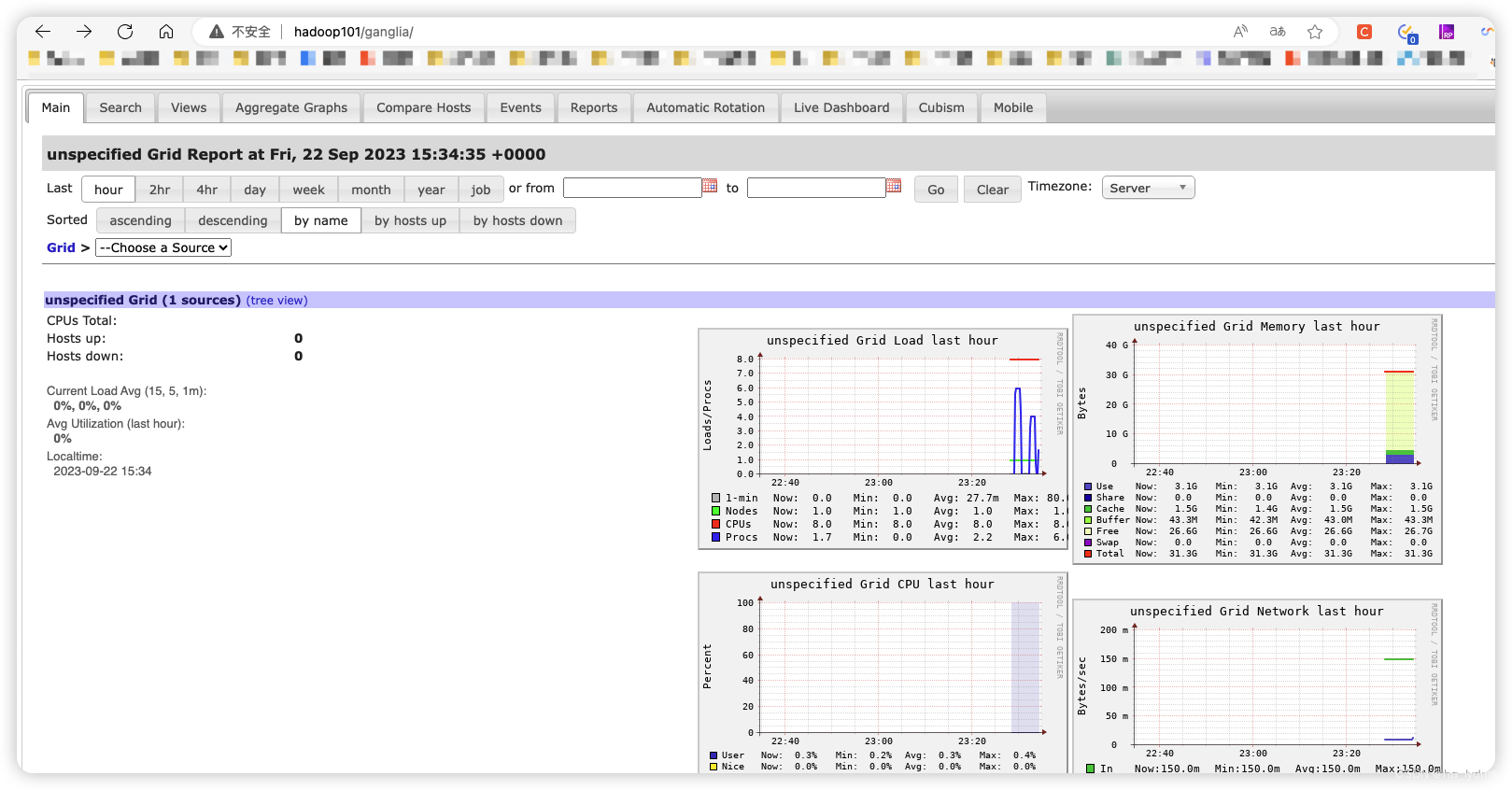
3、测试
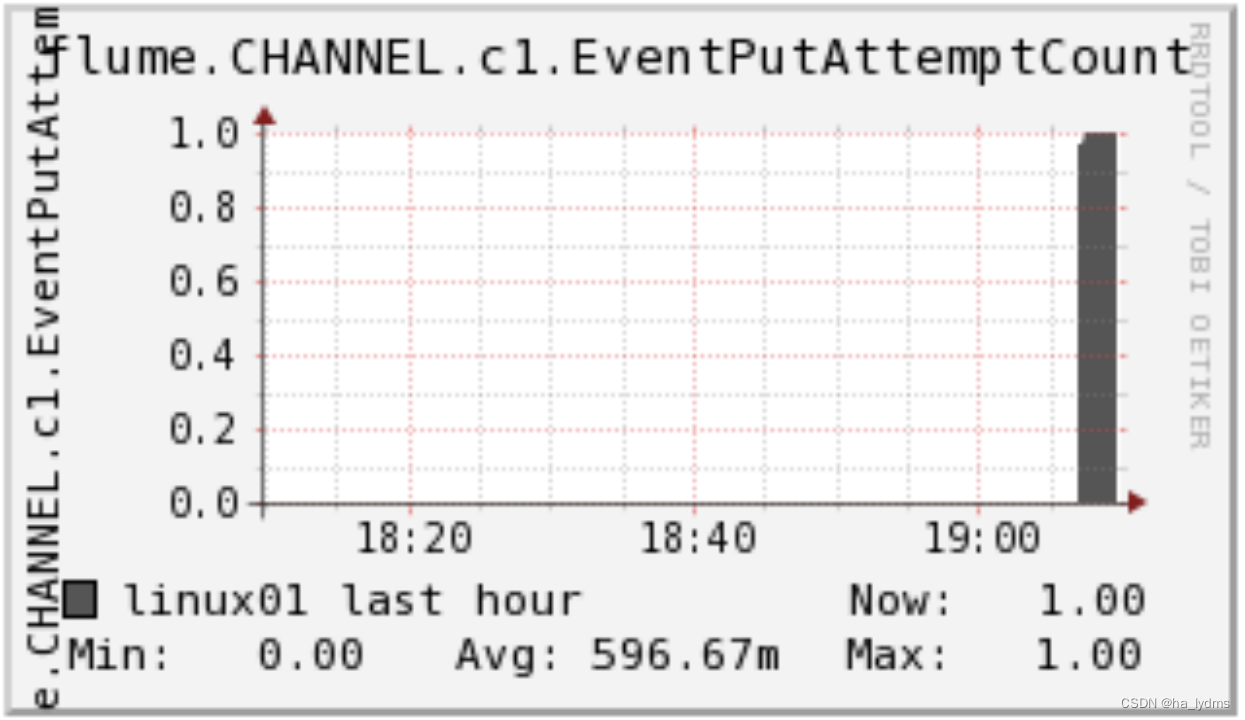 EventPutAttemptCountsource尝试写入Channel的事件总量 | 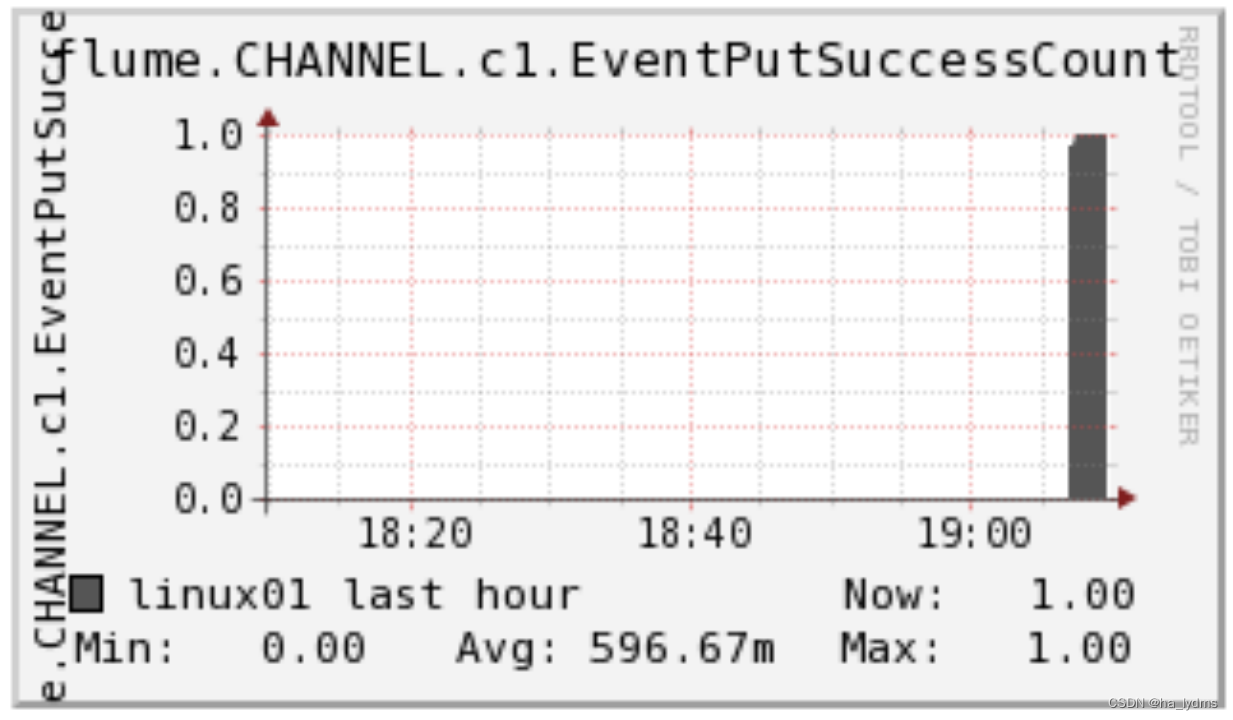 EventPutSuccessCount成功写入channel且提交的事件总量 EventPutSuccessCount成功写入channel且提交的事件总量 | 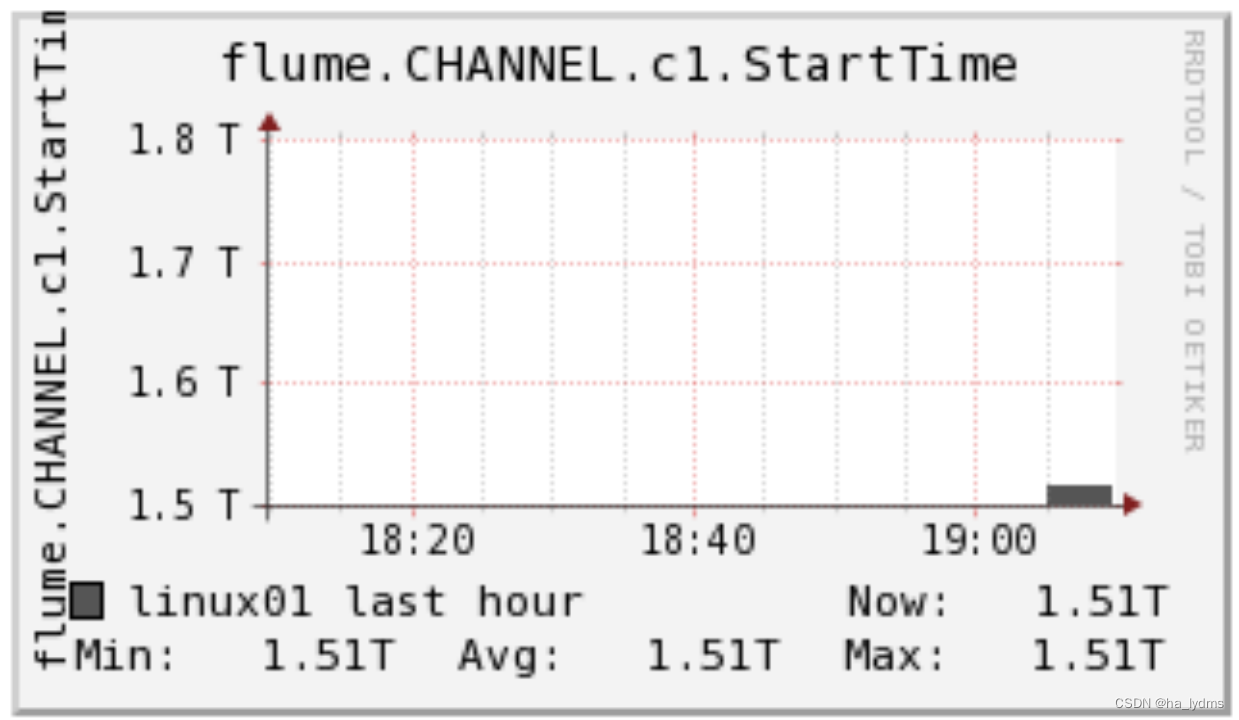 StartTimechannel停止时间 StartTimechannel停止时间 |
|---|---|---|
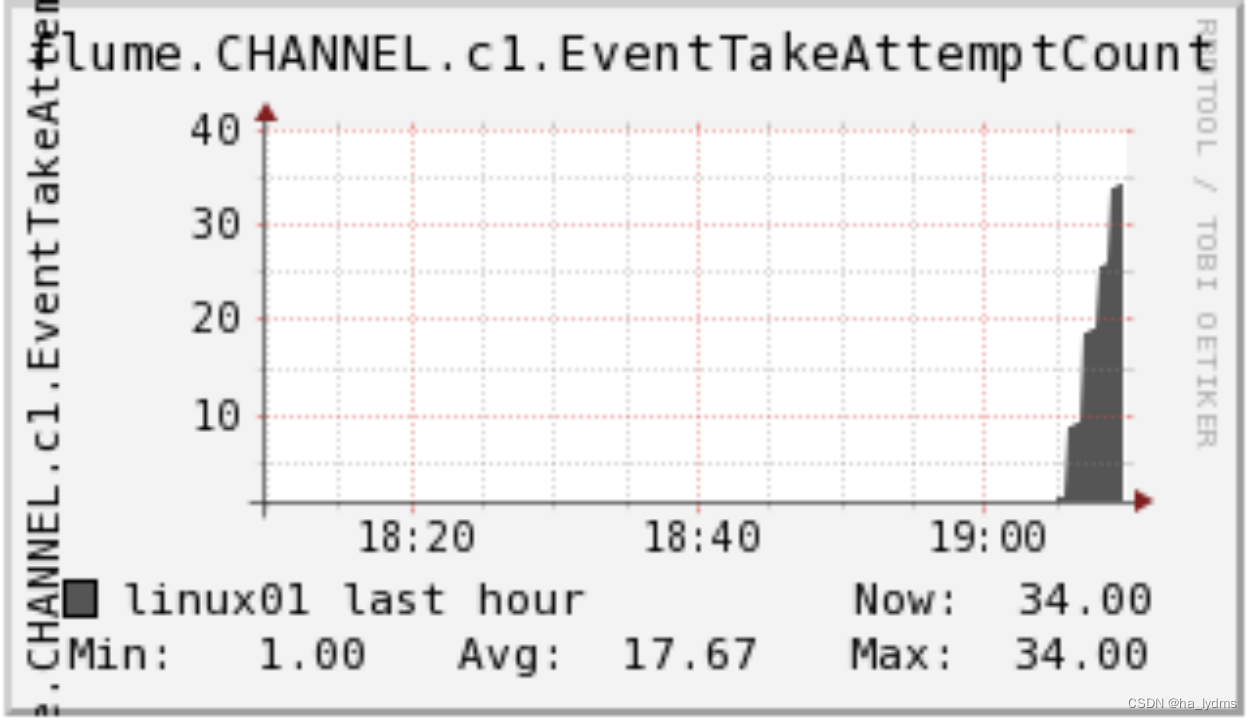 EventTakeAttemptCountsource尝试写入Channel的事件总量 EventTakeAttemptCountsource尝试写入Channel的事件总量 | 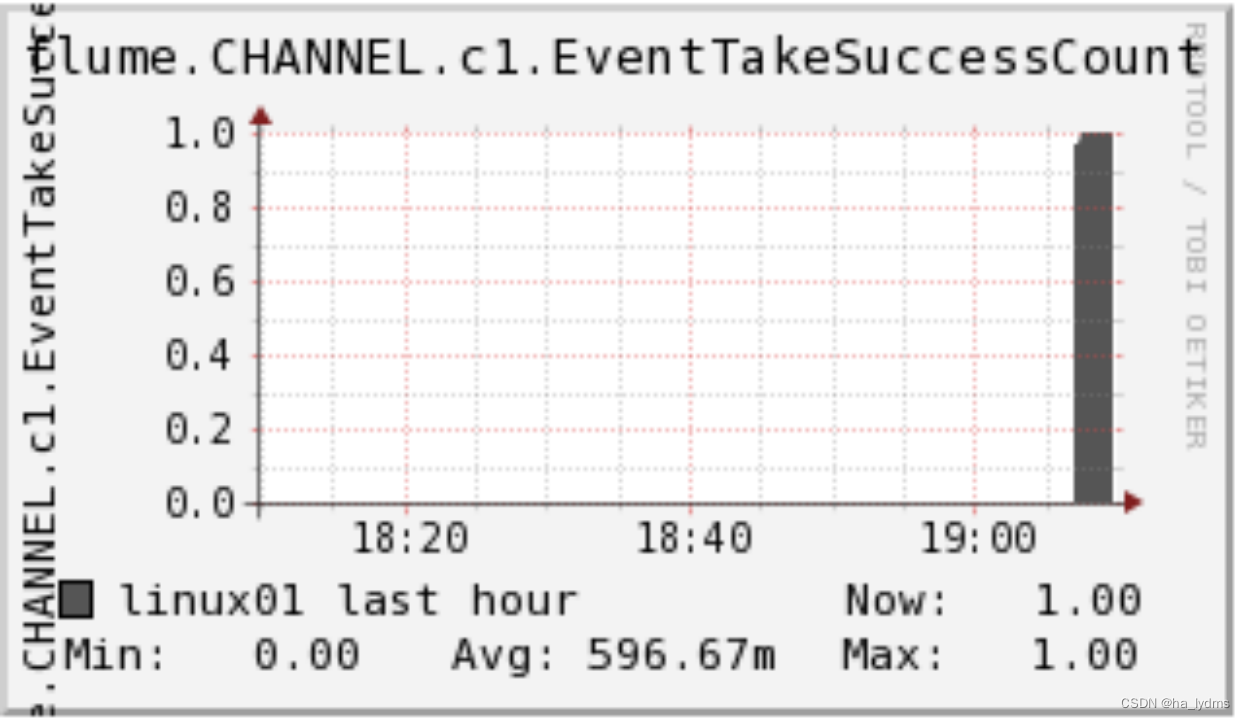 EventTakeSuccessCount成功写入channel且提交的事件总量 EventTakeSuccessCount成功写入channel且提交的事件总量 |  StopTimechannel停止时间 StopTimechannel停止时间 |
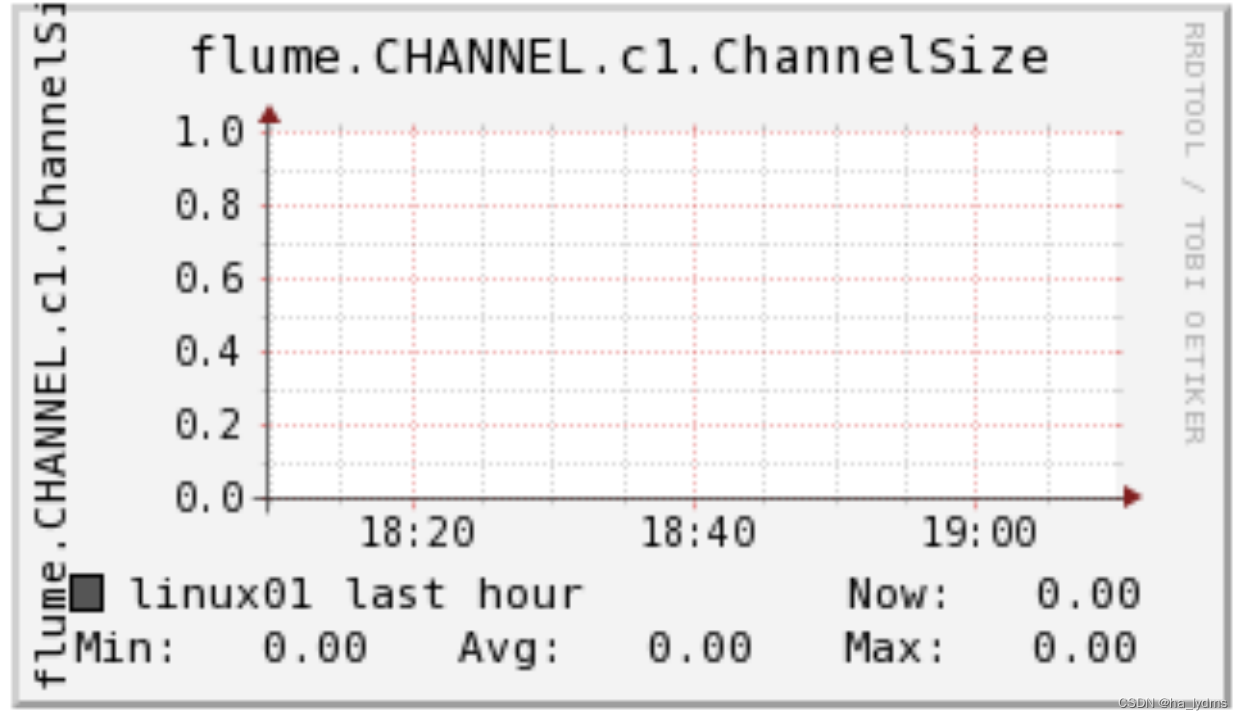 ChannelSize目前Channel中事件的总数量 ChannelSize目前Channel中事件的总数量 |  ChannelFillPercentagechannel占用百分比 ChannelFillPercentagechannel占用百分比 |  ChannelCapacitychannel的容量 ChannelCapacitychannel的容量 |

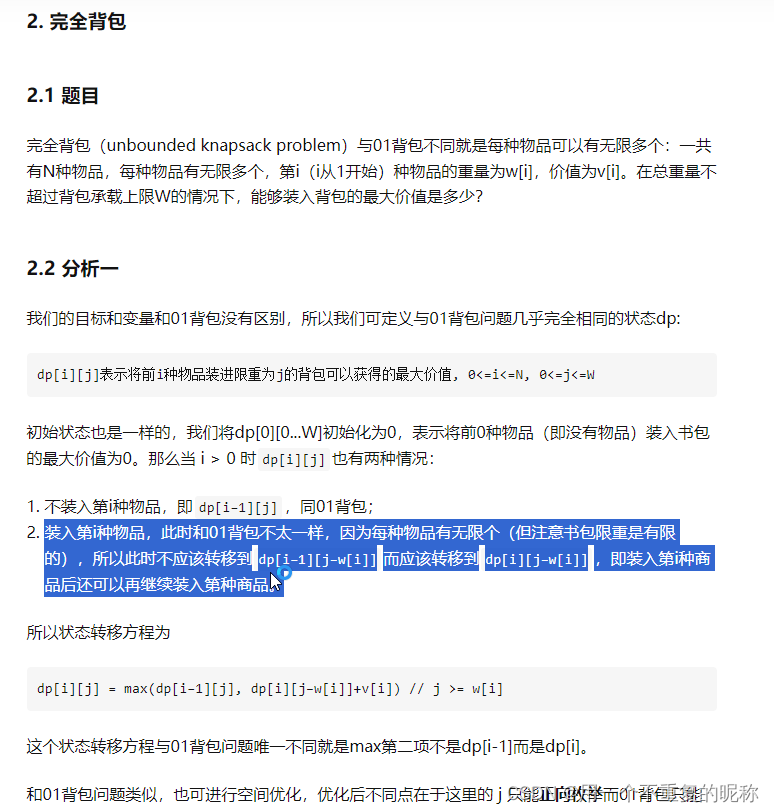

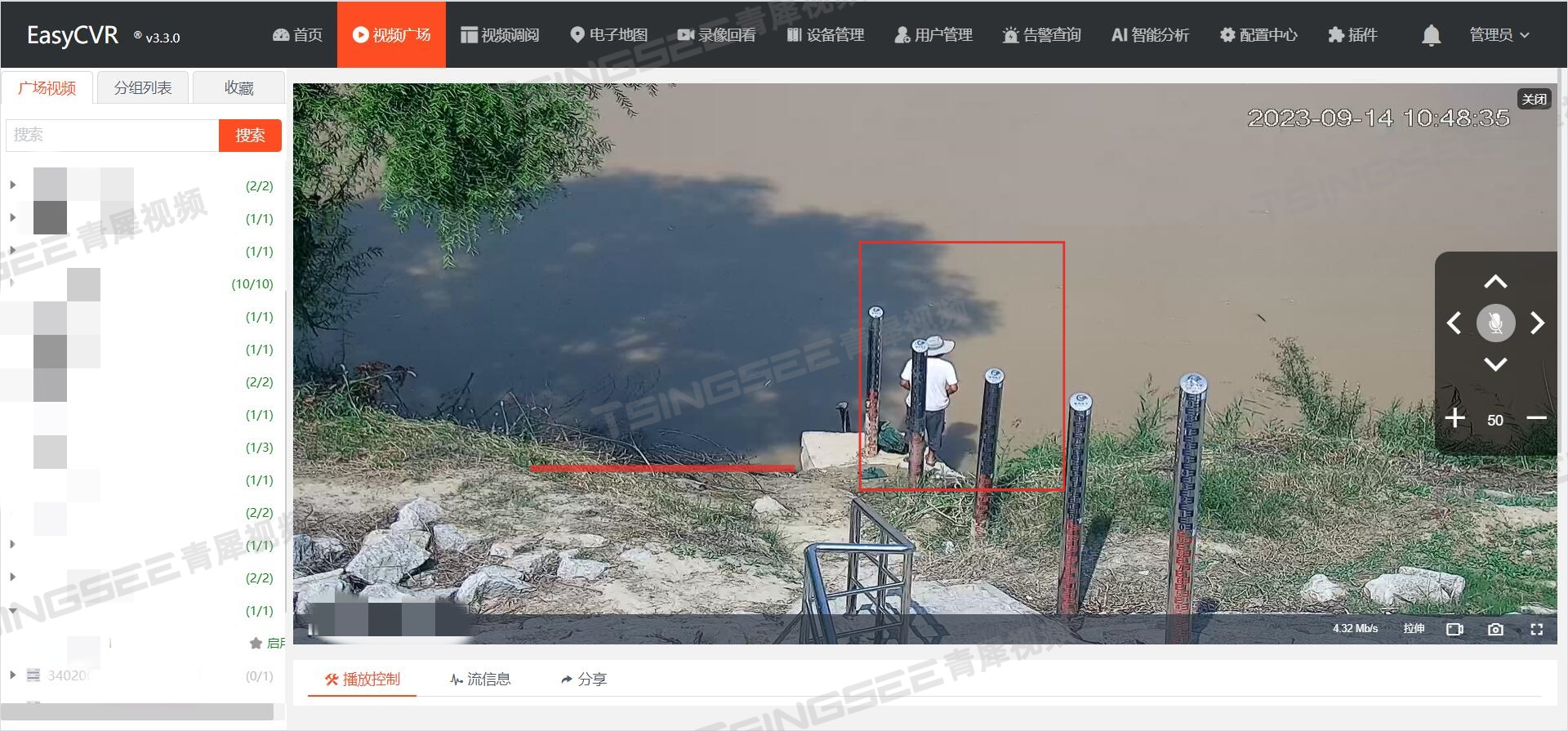
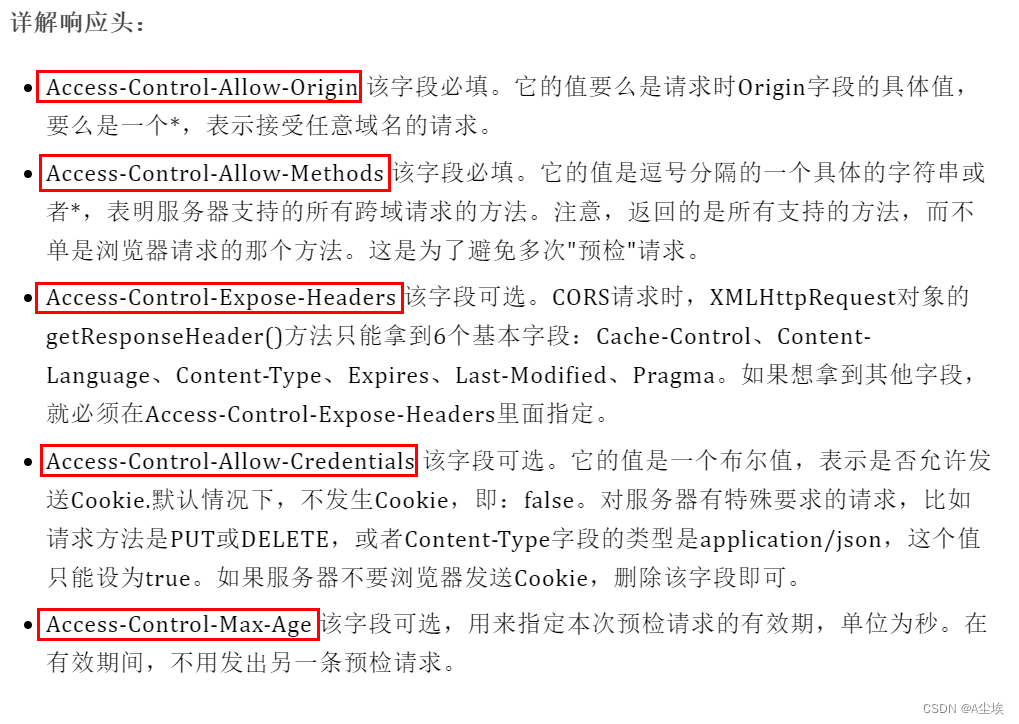



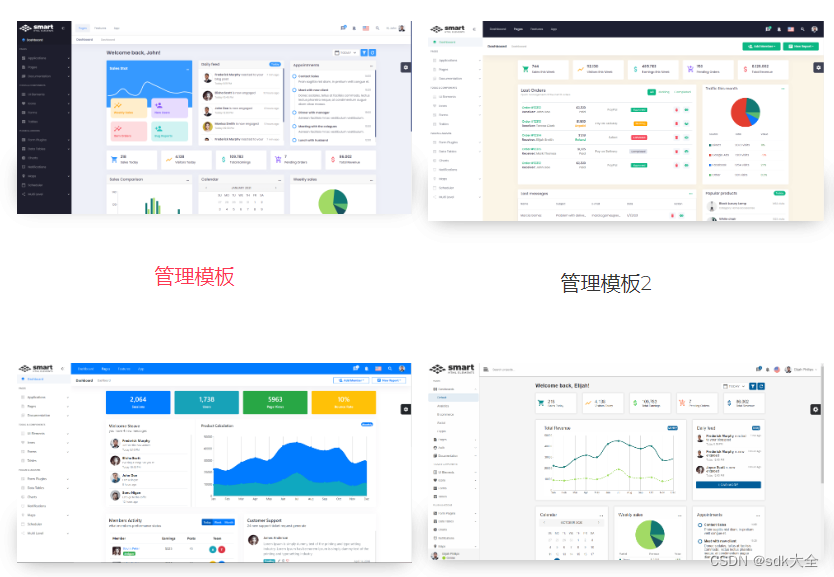


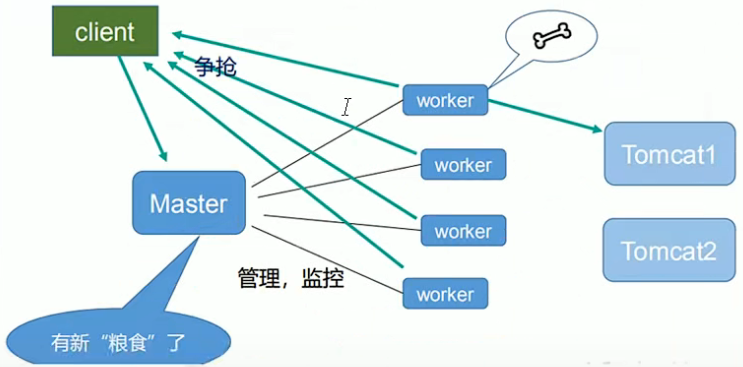
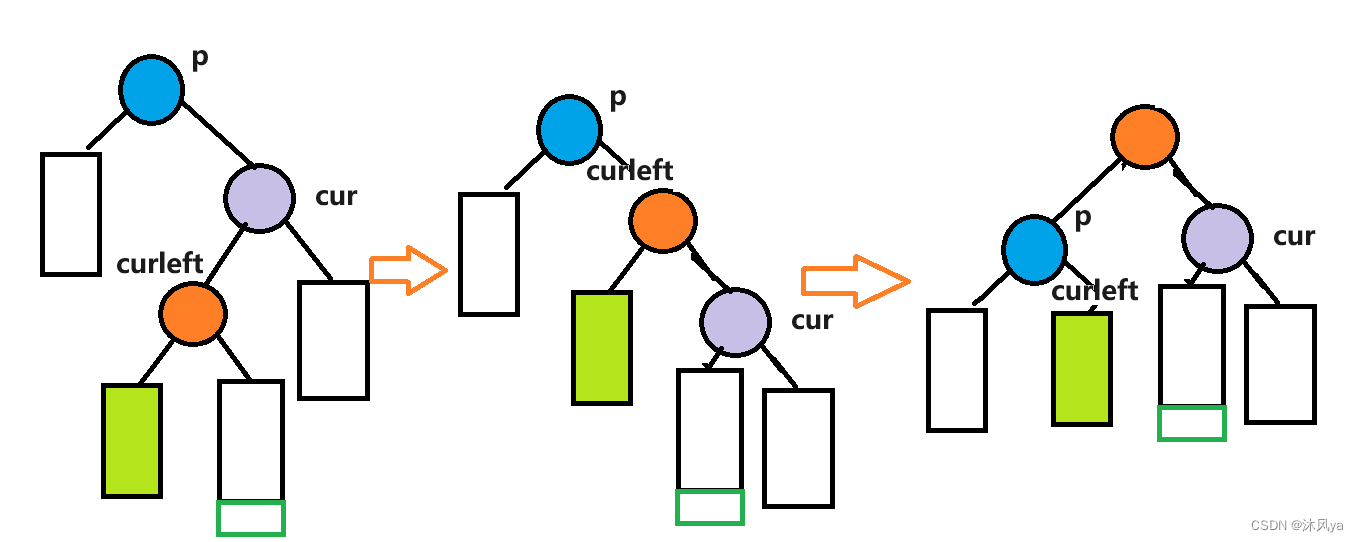

![[Linux入门]---git命令行的基本使用](https://img-blog.csdnimg.cn/6d6debcbca094727aae255b6987257da.png)
